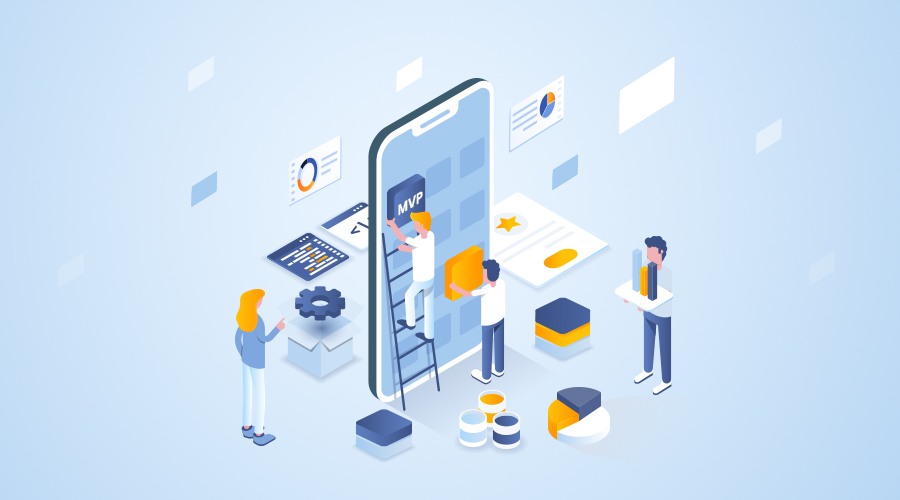With the penetration of smartphones, mobile apps have become much sought-after tools for leveraging the benefits of the internet. The benefits could include collating information, paying utility bills, buying tickets, playing games, doing banking transactions, and many more. Statistically, there will be an expected 255 billion app downloads in 2023, a massive 25 billion increase compared to 2022. However, not every app is lapped up by the audience, and a large number of them remain in the Play Store. Hence, it is important for mobile apps to be innovative, seamless to navigate, secure to operate, and meet the users’ expectations.
Today, it is crucial for businesses to validate their ideas quickly in the landscape of mobile application development. One way to achieve this is by developing a Minimum Viable Product or MVP. It allows businesses to test a concept, gain user feedback, and make iterative improvements. However, creating a successful MVP requires careful planning and execution. The blog explores the key steps to building a successful MVP for a mobile app.
Steps to Build an MVP for a Mobile App
Given the ubiquity of mobile apps and their key role as a market differentiator, businesses need to build a minimum viable product to validate their ideas. The steps to build such a minimum viable product are given below:
Define your goals and target audience
Define the problem your app solves and identify the core features that address it. Research your target market, understand their needs, and tailor your MVP to meet those requirements. By focusing on a specific audience and their pain points, you increase the chances of building a product that resonates with them.
Identify essential features
An MVP should focus on the core functionalities that solve the main problem. Avoid adding excessive features that can complicate the development process and confuse users. Start with a list of features that are crucial for the app’s basic functionality and prioritize them based on their importance. By keeping your feature set minimal, you can save time and resources during the initial development phase.
Create a user-friendly interface
Keep the design simple and consistent, and ensure that the app’s flow aligns with users’ expectations. Mobile app development services should conduct user testing and gather feedback during the design phase to make necessary improvements and refine your app’s user experience.
Develop a scalable architecture
While building an MVP, it’s crucial to consider the future scalability of your app. Choose a robust and scalable architecture that can accommodate additional features and handle increased user load as your app grows. Scalability is essential to ensuring a smooth transition from the MVP to a fully-fledged product without significant rework or performance issues.
Build for multiple platforms
In today’s mobile landscape, it’s essential to consider multiple platforms to reach a wider audience. Whether it’s iOS or Android, develop your MVP to work seamlessly across different platforms. Consider using cross-platform development frameworks like React Native or Flutter to save time and resources while maintaining a consistent user experience.
Implement analytics and tracking
Integrating analytics and tracking tools from the beginning will provide valuable insights into user behavior and help you make data-driven decisions. Track key metrics such as user engagement, retention rates, and conversion rates to understand how users interact with your app. Use these insights to iterate and refine your product based on real user data.
Plan for iterative development
An MVP is not a one-time release; it’s a starting point for continuous improvement. Plan for iterative development cycles, where you gather user feedback, make necessary adjustments, and release updated versions. Embrace an agile development approach that allows you to respond quickly to user needs and market demands. By continuously iterating and enhancing your app, you increase the chances of building a successful final product.
Gather user feedback
Actively seek feedback from your early users and pay close attention to their suggestions and pain points. Implement feedback loops through in-app feedback forms, surveys, or user testing sessions. Engage with your users to understand their needs, address their concerns, and make data-informed decisions for future iterations. Building a strong feedback loop helps you build a product that caters to your target audience’s requirements.
Monitor the market and competition
Stay up-to-date with the latest trends, market changes, and your competition. Monitor user reviews and ratings of similar apps to understand user sentiment and identify areas where your app can differentiate itself. Keep an eye on emerging technologies and features that can enhance your app’s value proposition. By staying informed and adaptable, you can make informed decisions and position your MVP competitively in the market.
Iterate and pivot based on feedback
The purpose of an MVP is to gather feedback and validate your assumptions. Be open to receiving feedback, both positive and negative, and use it to iterate and pivot when necessary. Pay attention to patterns in user feedback and prioritize improvements based on user needs and preferences. Remember, your MVP is a learning tool, and the insights gained from user feedback are invaluable in shaping the future direction of your app.
Plan for scalability and future development
As your MVP gains traction and validates its market fit, plan for scalability and future development. Incorporate a roadmap that outlines the additional features and enhancements you plan to implement in subsequent versions. Consider scaling your mobile web development team or partnering with external experts to meet the growing demands of your app.
Continuously test and optimize
Even after the initial launch of your MVP, the testing and optimization process should never cease. Use A/B testing to experiment with different versions of features, layouts, or pricing models to determine what resonates best with your target audience. Leverage analytics data to identify bottlenecks, optimize performance, and improve user engagement. Embrace a culture of continuous improvement to ensure your app remains relevant and competitive.
Conclusion
Building a successful MVP for your mobile app requires careful planning, understanding your target audience, and incorporating user feedback throughout the development process. By focusing on essential features, creating a user-friendly interface, and implementing analytics, any company, say a mobile app development company in USA, can gather valuable insights to refine its product. Embrace iterative development, stay informed about market trends, and be responsive to user needs. Remember, an MVP is not the end goal but a stepping stone towards building a successful mobile app.







